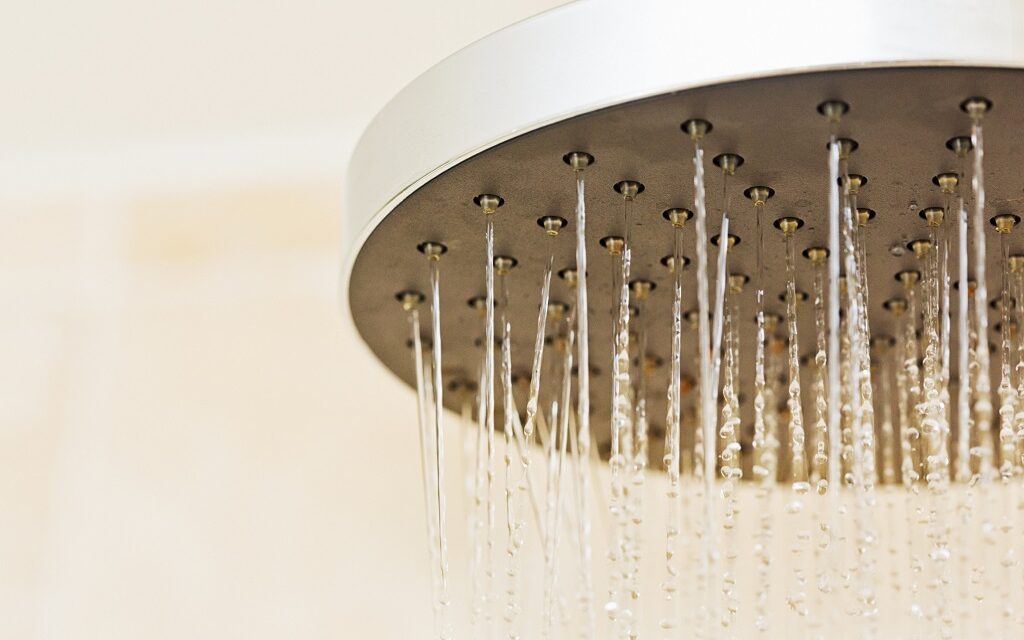Southern California was recently hit with an astronomical increase in the price of natural gas, which sent homeowners to online sites fuming about their hot water bills. A discussion ensued where homeowners with tankless heaters revealed that they were generally unscathed by the increase.
As other homeowners joined in with numerous questions pertaining to tankless heaters, we decided to submit the most frequently asked questions to licensed plumbers, who provided us insightful answers steeped in experience with both tankless and conventional tank water heaters.
8 Questions Homeowners Are Asking About Tankless Water Heaters
- Why Choose a Tankless over a Conventional Tank Heater?
- How Do You Choose a Tankless Water Heater?
- How Long Do Tankless Water Heaters Last?
- What are Some of the More Reputable Brands for Quality Tankless Water Heaters?
- What Type of Maintenance Must Homeowners Perform?
- Can a Conventional Tank Heater Be Used as a Standby?
- Are There Any New Advances in Tankless Water Heater Technology?
- What Are the Costs Involved in Owning a Tankless Water Heater?
Also see:
1. Why Choose a Tankless over a Conventional Tank Heater?
The advantages of tankless water heaters over traditional storage tank heaters can be succinctly summarized as:
- Space Savings
- Energy Savings
- Longer Lifespans and Warranties
- Advances in Innovation
With a tankless water heater, your home’s cold water is heated only when you need it, and it stays hot until you’re done using it. This results in a limitless hot water supply and little to no wasted energy usage.
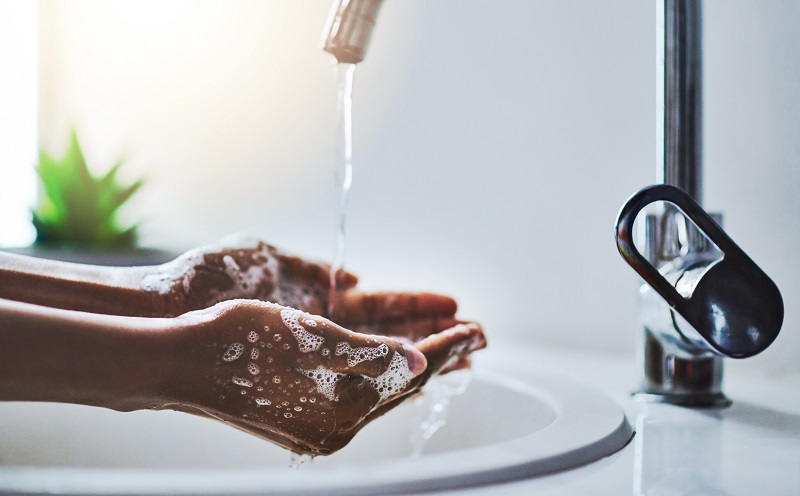
One of the basic reasons to choose a tankless hot water system is for the endless amounts of hot water. This is especially true if you have a household of “hyper-hygienic” people who insist on taking long, hot showers, or who like taking soaking baths. With a tankless water system, your home’s cold water is heated only when you need it, resulting in reduced energy waste.
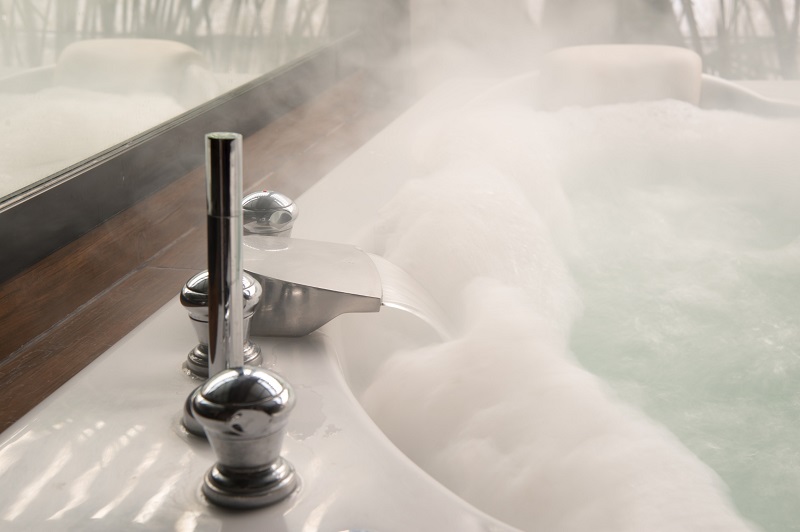
Tankless hot water systems, together with a recirculation pump, provide endless instant hot water on demand. Contrary to this, a tank system stores hot water in its large multi-gallon tank and must keep reheating the water to keep it at a set temperature to allow for “instant” hot water when you later turn on the tap.
Energy waste occurs if your water is constantly reheating throughout the day, but, for example, you don’t come home to take a shower until late in the evening. What’s the point of constantly heating water if there’s no need for hot water?
The best part of tankless hot water system is that it will save you money on your gas bill, as the efficiency of heating water on demand means that no water is left in a tank to cool down and reheat the reservoir when required.
Rinnai: How a Tankless Water Heater Works
Additionally, tankless systems take up a lot less space in your garage, or home, and can be mounted on the outside of your home, as many manufacturers build tankless systems to withstand the elements. Just make sure that the system you choose is specifically rated for outdoor installation.
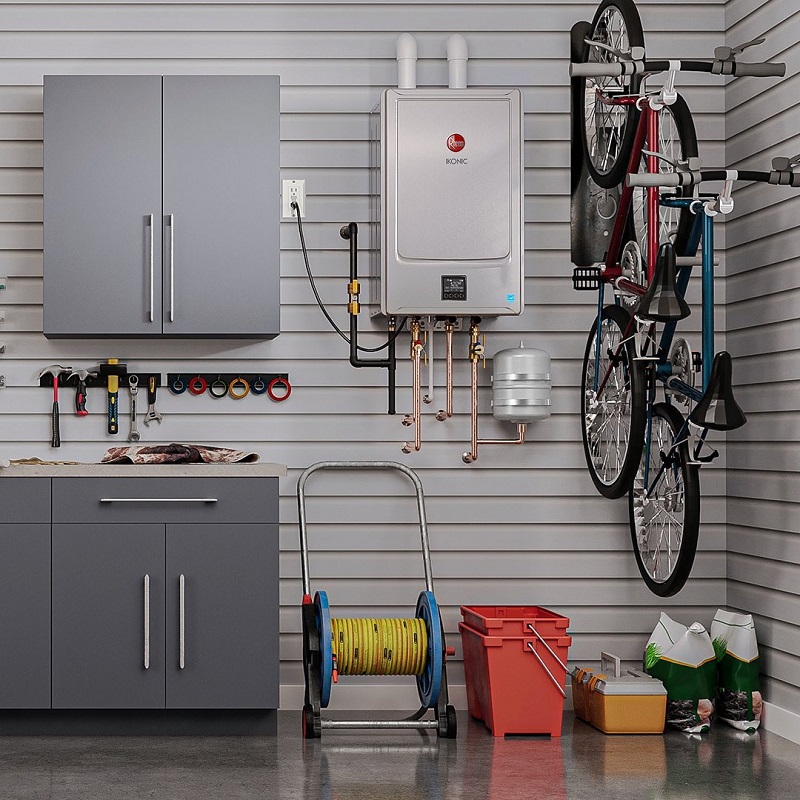
Image courtesy of Rheem
2. How Do You Choose a Tankless Water Heater?
The following variables need to be addressed to determine which type of tankless water heater is best suited for your needs:
Sizing
Choosing a tankless hot water system requires that you understand your average hot water usage patterns. The sizing calculation also takes into consideration the number of bathrooms in your home, the number of spray or shower nozzles in your home, as well as the number of stories that hot water needs to travel.
Also see:
Condensing vs. Non-Condensing
Next you need to choose between a condensing and a non-condensing unit. A condensing unit has a second heat exchanger, with an exhaust looped back into the system and causes the water to heat more efficiently.
Although a condensing unit is more expensive, they offer more flexible venting materials such as PVC and higher energy efficiency. However, condensation from the unit must be drained at the bottom of the unit. Condensing units are ideal for colder climates with low groundwater temperatures.
Non-Condensing units have only one heat exchanger, and has gas ventilated out of the top of the heater. As its name suggests, there is no condensation from this unit when it is properly vented. With simpler overall maintenance and lower initial cost, the non-condensing unit is ideal for warmer climates with higher groundwater temperatures
Fuel Type
For households with demanding hot water needs, gas tends to be the preferred fuel type for a tankless water heater. That said, if your home has all electric heating, then your tankless water system will need a gas source.
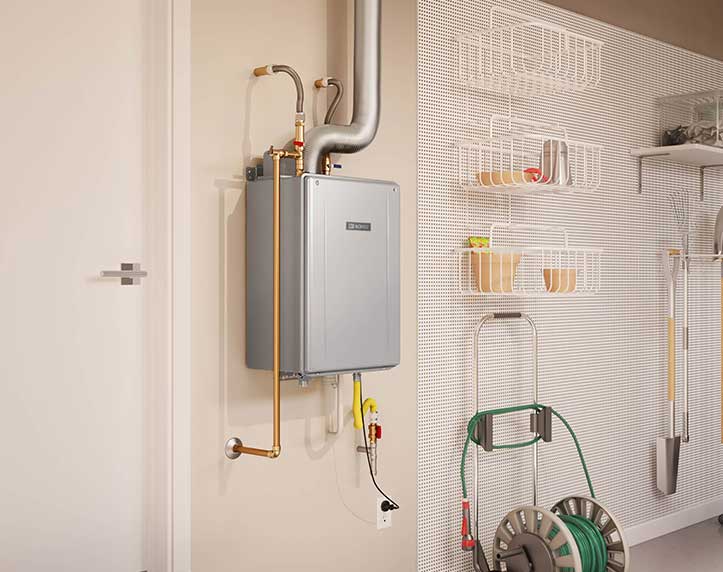
Image courtesy of Noritz
Propane is a viable option for those homes switching from all-electric to gas powered water heating. In homes with an existing natural gas source, there are many natural gas tankless options available. If your property is off-grid or located far from a city gas line, then a propane tankless heater may be a viable option.
It’s relevant to point out that electric tankless water systems are also available which use an electric element, instead of gas, to heat the flow of water. In general, tankless electric models are not as powerful as gas models, heat water more slowly, and would be better suited for small households in less-demanding, warmer climates. Two other drawbacks of electric models are that electricity costs are higher than gas, and their lifespans tend to be much shorter than gas models.
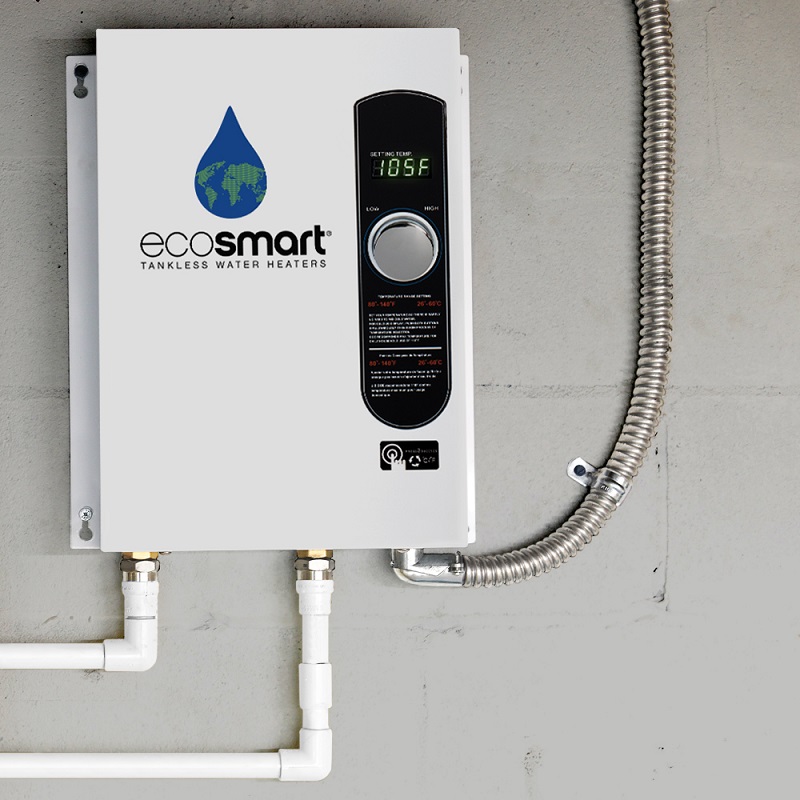
Image courtesy of EcoSmart
Electric tankless water systems, on the other hand, are easier to set up, cost less to install, and can be installed in small spaces, as they do not require ventilation.
Internal or External Mounting
Once you’ve sized the system correctly, determine where the unit will reside: indoor or outdoor, such as in a garage, in a utility closet, or directly outdoors, mounted to the home’s exterior wall.
The advantage of installing a tankless system outside is that not only is there a space savings, but there is less drywall damage and repair necessary for the initial installation. Since most exterior tankless systems are gas-powered and gas should already be accessible from your home’s exterior, an exterior installation will likely be feasible.
Exterior mountings are also ideal for service calls, as the technician need not enter the interior of your home for maintenance or repair.
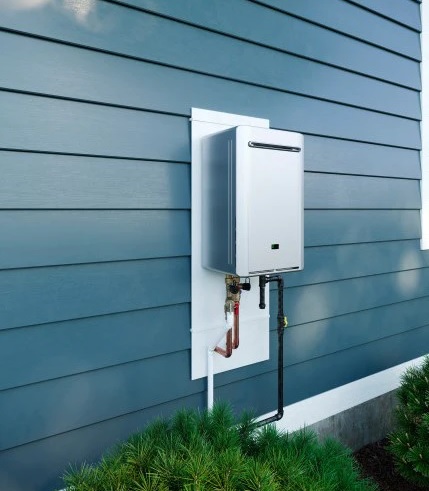
Externally mounted outdoor Rinnai tankless water heater
3. How Long Do Tankless Water Heaters Last?
On average, tankless water heaters have a longer life span than conventional tank heaters. With proper maintenance and water treatments, a tankless system can last from 15 to 30 years depending on the quality of the system and installation.
Raymond Gray, Owner of A-1 Total Service Plumbing in Los Angeles cautions:
“Picking a low-cost installer or company will likely not give you the full longevity of a unit. A customer should also look for details such as:
- A water filter and/or a pre-filter for their tankless unit
- Make sure there is a proper gas line set up
- Make sure there is a hard line to the electrical with a GFI and/or a weatherproof electrical box
- Insure that the expansion tank has proper venting
There is a small “laundry list of installation steps” that homeowners need to make sure their professional installer follows, not just for tankless heaters, but for conventional tank heaters, as well. Always follow the manufacturer’s installation requirements so that the manufacturer will honor the warranty later.”
The average life of a conventional tank system is 10 to 15 years where you begin to notice signs of aging, and wear and tear. This life span is dependent on the usage of the tank and the environment where it is stored. Obviously, tanks exposed to the elements will wear faster than those housed in a more hospitable environment. Remember, water sits in the tank contributing to this degradation, especially if you have hard water with corrosive minerals and salts.
The longer life span of the tankless heater is contingent upon the quality of the brand purchased and the correct installation method.
4. What are Some of the More Reputable Brands for Quality Tankless Water Heaters?
We spoke with several plumbers and they were unanimous in their recommendation of the following brands – Rinnai, Noritz, and Rheem – as being their preferred brands for service, quality, reliability and customer support.
5. What Type of Maintenance Must Homeowners Perform?
In order to keep your system performing at top efficiency, journeyman plumber, Melvin Perez, also from A-1 Total Service Plumbing, suggests the following procedures that can be performed by a homeowner:
- Descale your water heater if you live in a hard water environment
- Replace the heater treater filters once a year
- Be on the lookout for temperature fluctuations, the unit not reaching its “set water temperature”, and the unit taking longer to heat up
- Always have your unit professionally serviced by a licensed plumber every one to two years
Depending on the region, the average annual maintenance fee is $350. On the contrary the average annual maintenance fee for a conventional tank heater is $175 to $250 depending on the brand and type of water heater.
6. Can a Conventional Tank Heater Be Used as a Standby?
Yes. However, according to Gray:
For a single-family home, using the tank as a standby would not make sense, especially since this would come at an additional cost and take up a lot of additional room.
7. Are There Any New Advances in Tankless Water Heater Technology?
New models of tankless water heaters have incorporated modern technologies such as Bluetooth to allow homeowners remote access for turning the unit on and off. Bluetooth also allows you to control the water temperature with either a touch or voice command.
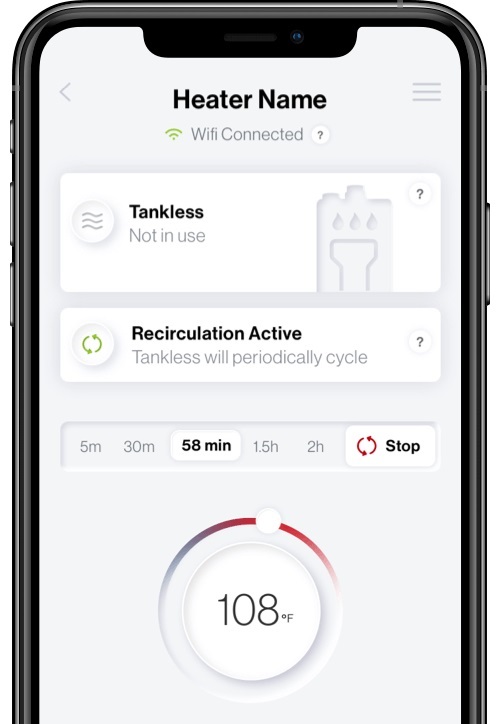
Screenshot of the Rinnai Control-R mobile app
If your system is connected to a recirculator, the Bluetooth option enables hot water to reach upper floors and areas furthest away from the heating unit faster. This is especially convenient and efficient for those who are often not at home and do not require continuous recirculating of hot water.
Homeowners are now able to monitor their unit remotely, as well as receive system alerts with online troubleshooting guides for faster remediation.
As mentioned previously, newer models allow propane as a gas option should you prefer to move off the natural power grid or to a remote area with less infrastructure.
8. What Are the Costs Involved in Owning a Tankless Water Heater?
Perez, states that the upfront investment in owning a tankless water system:
“…depends on the existing system and if you’re swapping out from a traditional tank to a tankless because the water lines will have to be reconfigured. Brand new tankless water heater could be $3,800 to $4,800. A swap out could be $1,900 to $2,900 with a 4-hour installation time.”
Tankless water heater installations can require as few as 4 hours, while needing up to a day and half, if follow-up adjustments and other fine tuning are necessary.
As previously mentioned, depending on your market, annual maintenance by a professionally licensed plumber averages around $350. The only other cost of ownership involves changing filters and descaling from hard water, should the homeowner choose to perform this himself. The cost of these activities is below $100 per year or when the unit is performing below expectations.
When estimating both upfront and on-going costs for a tankless water heater, be sure to incorporate estimated cost-savings. Estimates of a home water heater’s energy efficiency and annual operating cost are shown on the black and yellow Energy Guide label, while Canada uses a similar black-and-white “EnerGuide” label.
These performance numbers are helpful for comparing similar models, as well as calculating a payback period of investing in a more efficient model, which may have a higher purchase price.
According to the Department of Energy:
For homes that use 41 gallons or less of hot water daily, demand water heaters can be 24%–34% more energy efficient than conventional storage tank water heaters.
The bottom line to keep in mind is that you will enjoy experiencing reliable, on-demand hot water and on-going savings for many years to come with the right system, installation and maintenance plan.
Additional Recommended Plumbing Reading
- Part 1: Non-Invasive Plumbing Tech for Repairing Your Home’s Sewer Line
- Part 2: Non-Invasive Plumbing Tech: Bids, Proposals & Lessons Learned
- Part 3 Non-Invasive Plumbing Tech: How We Repaired Our Home Sewer Line
- A Simple Guide to Choosing a Water Softener System
- How to Choose a Water Leak Detection System for Your Home
- Repiping Your House: Early Signs It Might Be Time To Repipe
- 20 Best “How-To” YouTube Videos for Home Maintenance
| Purgula is reader-supported. When you click on links to other sites from our website, we may earn affiliate commissions, at no cost to you. If you find our content to be helpful, this is an easy way for you to support our mission. Thanks! Learn more. |

